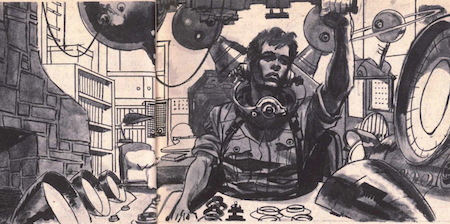Science Fiction
Dictionary
A B C D E F G H I J K L M N O P Q R S T U V W X Y Z
Latest By
Category:
Armor
Artificial
Intelligence
Biology
Clothing
Communication
Computers
Culture
Data Storage
Displays
Engineering
Entertainment
Food
Input Devices
Lifestyle
Living Space
Manufacturing
Material
Media
Medical
Miscellaneous
Robotics
Security
Space Tech
Spacecraft
Surveillance
Transportation
Travel
Vehicle
Virtual
Person
Warfare
Weapon
Work
"Science fiction is really sociological studies of the future, things that the writer believes are going to happen by putting two and two together."
- Ray Bradbury
| Way Station Materializer | ||
| By sending impulses that describe a creature from star to star, transport across the galaxy is accomplished. |
This is the first description of this process that I know about, in a novel anyway.
| Moments ago the creature in the tank had rested in another tank in another station and the materializer had built up a pattern of it - not only of its body, but of its very vital force, the thing that gave it life. Then the impulse pattern had moved across the gulfs of space almost instantaneously to the receiver of this station, where the pattern had been used to duplicate the body and the mind and memory and the life of that creature now lying dead many light years distant.
And in the tank the new body and the new mind and memory and life had taken almost instant form - an entirely new being, but exactly like the old one, so that the identity continued in the consciousness (the very thought only momentarily interrupted), so that to all intents and purposes the being was the same. There were limitations to the impulse patterns, but this has nothing to do with the speed, for the impulses could cross the entire galaxy with but little lag in time. But under certain certain distances the patterns tended to break down and this was why there must be many stations, many thousands of them. Clouds of dust or gas or areas of high ionisation seemed to disrupt the patterns and in those sectors of the galaxy where these conditions were encounter end, the distance jumps between the stations were considerably cut down to keep the pattern true. There were areas that had to be detoured because of high concentrations of the two stars and gas and dust.
 (Materializer from 'Way Station' by Clifford Simak) Enoch wondered how many dead bodies of the creature a good now rested in the tank has been left behind at other stations in the course of the journey it was making, as this body in a few hours time would lie dead within this tank when the creatures pattern was sent out again, riding on the impulse waves. A long trail of dead, he thought, left across the stars, each to be destroyed by a wash of acid and flushed into deep lying tanks, but with the creature itself going on and on until it reached its final destination to carry out the purpose of its journey. |
| Technovelgy from Way Station,
by Clifford Simak. Published by Doubleday in 1963 Additional resources -
|
Compare to cosmic express from the 1930 short story of that name by Jack Williamson, the nutrient gelatin tank from The Isotope Men (1936) by Nat Schachner and the emergency treatment tank from Agent of Vega (1949) by James Schmitz.
Comment/Join this discussion ( 0 ) | RSS/XML | Blog This |
Additional
resources:
More Ideas
and Technology from Way Station
More Ideas
and Technology by Clifford Simak
Tech news articles related to Way Station
Tech news articles related to works by Clifford Simak
Way Station Materializer-related
news articles:
- 3D Printer 'Teleports' Objects Like Simak's Way Stations
- Is Teleportation A Death Sentence?
- Prototype 3D Printer Could Print Arteries In Seconds
| Will Space Stations Have Large Interior Spaces Again? |
| Reflect Orbital Offers 'Sunlight on Demand' And Light Pollution |
| Chrysalis Generation Ship to Alpha Centauri |
| The First Space Warship For Space Force |
Want to Contribute an
Item?
It's easy:
Get the name of the item, a
quote, the book's name and the author's name, and Add
it here.
| <Previous | Next> |
|
|
|
Technovelgy (that's tech-novel-gee!) is devoted to the creative science inventions and ideas of sf authors. Look for the Invention Category that interests you, the Glossary, the Science Fiction Invention Timeline, or see what's New.
|
Science Fiction
Timeline
1600-1899
1900-1939
1940's 1950's
1960's 1970's
1980's 1990's
2000's 2010's
'Buy a Little Dingbat... electropen, wrist watch, pocketphone, pocket radio, billfold ... all in one.'
'... an elastic, tinted material that had all the feel and appearance of human flesh and epidermis.'
'It is remarkable that the long leverages of their machines are in most cases actuated by a sort of sham musculature...'
'Briquet’s head seemed to think that to find and attach a new body to her head was as easy as to fit and sew a new dress.'
'...copy was turned out in a charming and entirely feminine handwriting.'
'It was almost unheard of for slunch to spread that fast...'
'He then started hand movements of definite pattern...'
'The leg was to function, in a way, as a servo-mechanism operated by Larry’s brain...'
